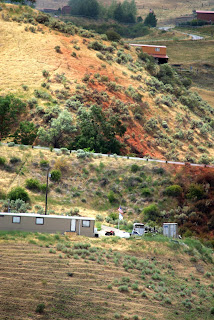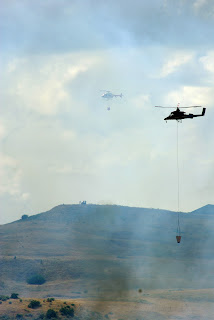We're back in the house now, but some of our neighbors had fire 30 feet from their homes.
Channel 2 did a live broadcast with me.
We grabbed my laptop, and the cat--and the cat, in panic, sunk his claws into my inner lip, and refused to let go. We set up at the vista point 1 1/2 miles away on the new highway, along with the various television crews.
Fire retardant air strikes from surprisingly small planes:
Of course, there was the retardant orange afterwards:
And yes, for those of us who are very sharp-eyed--that's an Israeli flag flying from my neighbor the electrician's home.
Lots of air traffic to deal with the fire:
Looking rather like a large and dangerous insect, you can see one of the four helicopters carrying its water bucket:
Here's one of the other choppers, after having dumped its load:
I don't think there were any injuries, but probably in case there was a need, our volunteer fire department rolled the ambulance.
Our neighbors' homes saved at the last minute:
One of the choppers carrying his bucket in front of our house.
I've never been close to catch pictures of the water bucket dumps before, and it's awesome! It must be even awesome on the ground. My neighbor Chuck was using his hose, trying to save his house when suddenly...he was soaked. This might have been the drop, since they were dropping on his house with this one:
Here's a sequence that really captures how dramatic this is:
Fire suppression involves reducing temperature, eliminating fuel, or preventing oxygen. A water drop does two of the three pretty effectively. Watching one of these dumps onto a fire turn into steam is very gratifying. Here's a great dump:
And here's a sequence that I think almost everyone can appreciate:
UPDATE: A reminder that it is an ill wind indeed that does not produce a positive benefit for someone. I started talking to someone who owns a nearby parcel, but who has never built a house on it because he couldn't find adequate water. This led me to discuss the very successful methodology that I used to place our well. (Successful: I said we would hit water at 120 feet; instead, it was 127 feet.) At this point he asked me, "What do you do for a living?" "Software engineer." It turns out that he runs a company that writes mobile app software. One thing led to another, and he gave me his email address to send a resume.
UPDATE 2: Not terribly surprising: our land line service is out.






































A good time to get remind Instapundit to plug your book!
ReplyDeletescary stuff
ReplyDeleteonly been close to one once near the Great Smokey Mtn National Park, during a controlled burn that got a little out of control
our boy scout troop had a more interesting and shorter hike than expected, but nothing like what is occurring near you.
I pray for rain. God, in your mercy for our sinfulness, give us rain and new life.
Amen
We would like to find out about your method for placing a well.
ReplyDeleteGlad everything turned out OK.
The well was actually more laborious than difficult. I downloaded all the well drilling logs that the Idaho Department of Water Resources has. (By law, they must be filed after every well is drilled.) Then I went to all the wells drilled in my area, using a GPS receiver to determine their exact location and elevation.
ReplyDeleteNext, I used the Idaho Bureau of Mines publication, Engineering Geology of the Cartwright Quadrangle, published back in the 1950s because of all the problems that they had keeping the old state highway that runs through this area from sliding away. This includes detailed maps of the underlying bedrock (age, type), and a detailed discussion of the water table related problems of the slip-sliding away highway. From the test wells drilled back then, and the current well logs, I was able to construct a model of underground water table flows in this section.
I won't claim that it was terribly spectacular, but I was able to determine from this information that the Tertiary period basalt outcropping on which we were going to construct the house was an effective water block, based on the dry holes downslope from it, and the sometimes spectacularly successful wells downslope from the Quaternary period sandstones that make up the north and south parts of my property.
I could probably have drilled successfully on the south side, but the north side had more successful drills downslope from areas that were easy accessible to the well drilling rig, so that's the spot I picked. I calculated likely drop of water table per linear foot relative to other wells, and figured that we would hit water at 120 feet.
As I said, pretty simple.
Glad to hear everything is ok.
ReplyDeleteYour procedure reads like a spec for a mobile app. Would it be worth $0.99 to get a tutorial app to avoid even one dry hole? Of course it would.
ReplyDeleteHmmm. I was wondering what the first Android app should be...
ReplyDeleteFYI, they're using a Kamen K-MAX to drop the water, which is the basis for the K-MAX load-carrying drone being tested in Afghanistan.
ReplyDeletehttp://en.wikipedia.org/wiki/Kaman_K-MAX
Cheers
The Kaman K-MAX is quite a workhorse for heavy sling load lifting. Only the Russians have anything bigger. Somewhere I have some pictures of one I climbed all over at the HAI helicopter expo back in the 90's. Pretty impressive machine.
ReplyDeleteGlad to hear the fire didn't make it to you. Too close for comfort though I'm sure!
That's a "Bambi bucket" in firefighter slang.
ReplyDeleteI'm glad You and Your Family are safe. Scary times. Take Care.
ReplyDeleteYou might be interested in this short interview with Chick Keller, a retired physicist who formerly worked at Los Alamos National Laboratory. Keller has a personal interest in the subject, as his house was burned to the foundation in May 2000 by the Cerro Grandé forest fire. I very rarely agree with Keller, but I think most of his remarks, save for letting the Air Force actually conduct the work, are reasonable.
ReplyDeleteUnless frame 32 is some sort of artifact of imaging, the amount of rotor flex depicted there is astounding to this admittedly naive observer.
ReplyDeleteThis is the Bambi Bucket as trademarked:
ReplyDeletehttp://www.sei-ind.com/products/bambi-bucket-systems
Cheers
The K-MAX has two twin-blade rotors which are mounted side-by-side. The rotors have to intermesh, and thus the rotor shafts are set about ten degrees from vertical. Then the rotors are geared to rotate 90 degrees apart.
ReplyDeleteWhat appears to be blade flex is actually the underside of the rotor which is angled away from the camera.
Cheers
Your government money at work. Remember that the next time you rant about it.
ReplyDeleteWhich of my rants about government can you point to? You see, being a conservative, I don't object to government. I have even blogged of late that cutting tax rates might have made a lot of sense at one time, but it doesn't now. Income tax rates are historically quite low.
ReplyDeleteAnonymous, I would also add that it's not hypocritical to think that tax dollars should be used to fight fires, but then oppose all the numerous ways taxes are then wasted on failed programs, some of which destroy our liberties!
ReplyDeleteI hate this notion that, if we enjoy police and teachers and fire fighters, we have to shut up and accept absurd tax rates that pay for government programs that hurt us.